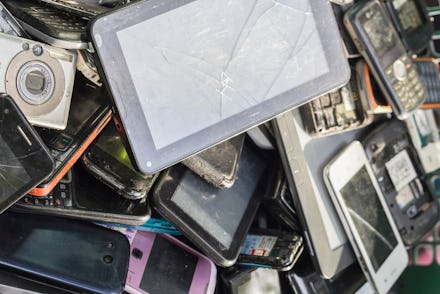How to recycle your old electronics

We use a lot of technology. In fact, in 2014, the Independent reported that the number of active mobile devices in the world surpassed the number of people on the planet. In the United States alone, Pew Research Center reported, one-third of Americans live in a household of three or more smartphones, in addition to other electronics like tablets, laptops and streaming media devices. And because these products don’t exactly last forever, we also discard a lot of technology. According to the United Nations, 44.7 million tons of electronic waste, or e-waste, were generated in 2016. Only about 20 percent of that was recycled, which means about 35 million tons of electronics were tossed in the trash in a single year.
And that’s a problem. “Many materials contained in electronic devices can be harmful to the environment and to human health if not properly managed,” said Patty Osterberg, director of education and outreach at Sustainable Electronics Recycling International (SERI), citing examples like lead and mercury. “When electronics are improperly disposed of, these and other harmful substances can contaminate the soil, water and air. ...If incinerated, the toxins are released into the air we breathe.”
Not only that, but devices with Lithium Ion batteries (such as phones and computers) also pose an immediate safety risk. “The high density of the lightweight battery can hold up to an 80 percent residual charge after it no longer powers devices,” said Dori Mendel, director of communications at Call2Recycle. “That fact makes these battery types a risk if not properly handled, transported and managed. After a battery enters the trash, especially if not properly protected, it encounters a number of instances where a spark could occur…[like] jostling around in a garbage truck against other materials and then co-mingling with other materials onsite at local household hazardous waste facilities.”
But there are ways to avoid that endgame. Many electronics can be refurbished and reused, and even those that can’t contain valuable materials and resources that can be salvaged. If you have any old devices lying around, bypass the trash can and take one of these paths to recycling instead.
Trade it in for cash or credit
You may be ready for to ditch your device in favor of an upgraded model, but that doesn’t mean the old one is worthless: Lots of tech retailers and manufacturers, like Amazon, Apple, Target, Best Buy, Sprint and Verizon, will give you cash or store credit for your used electronics. The amount varies based on your device and the state it’s in; but any little bit can help offset the cost of your next purchase. Not only that, but the trade-ins also benefit the retailers (who can resell refurbished devices) and the environment. “Even more environmentally beneficial than recycling is extending the life of electronic devices through responsible reuse,” Osterberg said. “Reuse greatly reduces the environmental footprint of electronics and has the added social benefit of bridging the digital divide by providing tested and refurbished electronics at an affordable price to people that can’t afford to buy new. R2 certified refurbishers and recyclers have rigorous procedures in place for destroying all data and testing and repairing reusable electronics.”
If you want to trade in an old device, you can contact the manufacturer or store where you purchased it; or search for a certified refurbishing facility through a site like SERI. Osterberg recommended doing so as soon as you’re done with the device, as “the older [it is], the more likely it will be obsolete and the reuse value is lost.”
Bring it to certified recycler
It’s possible your device won’t have any monetary trade-in value (for example, if it’s too old or too broken); but even in that case, it’s important to make sure its pieces are recycled through the proper channels. “All electronics should be recycled with a responsible, certified recycler,” Osterberg said. “Unfortunately, not all recyclers manage used electronics responsibly — some may illegally export, landfill or incinerate low value, end-of-life devices rather than paying the cost to safely recycle the materials. Using a certified recycler is important to ensure that recyclers are following best environmental, health and safety practices and undergo the scrutiny of annual audits.”
Many of the aforementioned retailers have official recycling programs (and may even take items that were purchased elsewhere); but depending on where you live, you may have many other options, including electronics cycling services offered by your local government. Sites like E-Stewards, TIA E-Cycling Central, SERI and Call2Recycle make it easy to locate recyclers in your area. Not all recyclers take all types of devices, though, so make sure you confirm your device will be accepted before you drop it off.
Donate it to charity
There are plenty of people around the world who don’t have easy access to electronics — and there are also plenty of people working to change that with the help of donations. Programs like Dell Reconnect, National Cristina Foundation, Secure the Call, World Computer Exchange and Medic Mobile can give your used devices second lives by refurbishing them (if necessary) and getting them into the hands of people and organizations who need them. In many cases, if the devices can’t be refurbished, the organizations will properly recycle them. You can also sell used electronics yourself through eBay for Charity, and donate all or some of the proceeds to a certified charity of your choosing.